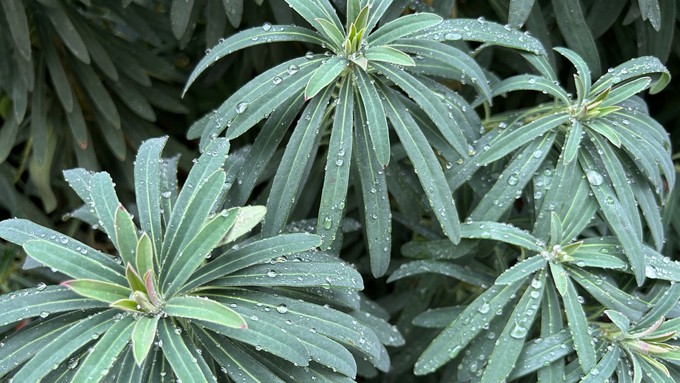
Watch out for leaning trees and cracked soil

Raindrops dot this euphorbia plant after Wednesday morning's storm. The Sacramento region received varying amounts of rainfall this week. Kathy Morrison
How much rain did you get? Chances are – a lot!
Sacramento’s first atmospheric river of the 2023-24 rainy season gave our region a good, deep soaking. Starting Sunday night through Tuesday midnight, Downtown Sacramento recorded 2.61 inches, according to the National Weather Service. That includes a record 1.6 inches on Tuesday, Dec. 19.
Other parts of the greater Sacramento area received more – or less. Here in the Pocket/Greenhaven neighborhood, my rain gauge collected just under 4 inches. That includes some showers from Wednesday morning.
Meanwhile, Davis recorded only 1.24 inches since Sunday, says the weather service.
Rain totals from the thunderstorms that blew across our region Tuesday afternoon illustrate the hit-or-miss tendency of this storm system. Sacramento Executive Airport recorded 1.55 inches in the 24-hour period of 4 a.m. Tuesday-Wednesday, according to the California Nevada River Forecast Center, a part of the National Oceanic and Atmospheric Administration. For that same period, Elk Grove received only 0.16 inches.
Also for that same 24 hours, Sacramento State’s rain gauge recorded 1.06 inches while the gauge at Arcade Creek-Winding Way in Carmichael received only 0.39.
While much of Sacramento was getting drenched Tuesday, Roseville, Fair Oaks, Rocklin, Orangevale, Lincoln and Rancho Cordova all recorded less than one-third inch.
A lot of rain in a hurry not only leads to possible flooding; it can destabilize trees – especially if followed by strong gusts of wind.
After the rain stops, take a look around your landscape. If you notice a tree leaning or cracks in the lawn or soil around a tree or large shrub, call an arborist. Those cracks are caused by roots being pulled out of place. You may need expert help to keep that tree upright.
Also be careful walking on wet soil; it can compact easily, squeezing out the vital air pockets needed by roots and microorganisms.
For more on Sacramento weather: https://www.weather.gov/sto/#.
Comments
0 comments have been posted.Sacramento Digs Gardening to your inbox.
Food in My Back Yard Series
April 1: Don't be fooled by these garden myths
March 25: Fertilizer tips: How to 'feed' your vegetables for healthy growth
March 18: Time to give vegetable seedlings some more space
March 11: Ways to win the fight against weeds
March 4: Potatoes from the garden
Feb. 25: Plant a fruit tree now -- for later
Feb. 18: How to squeeze more food into less space
Feb. 11: When to plant? Consider staggering your transplants
Feb. 4: Starting in seed starting
Sites We Like
Garden Checklist for week of March 30
Your garden doesn’t mind April showers. Get busy now to enjoy those future flowers.
* Get ready to swing into action in the vegetable garden. As nights warm up over 50 degrees, start setting out tomato, pepper and eggplant transplants.
* From seed, plant beans, beets, cantaloupes, carrots, corn, cucumbers, melons, pumpkins, radishes and squash. (Soak beet seeds overnight in water for better germination,)
* Plant onion sets.
* In the flower garden, plant seeds for asters, cosmos, celosia, marigolds, salvia, sunflowers and zinnias.
* Transplant petunias, zinnias, geraniums and other summer bloomers.
* Plant perennials and dahlia tubers for summer bloom.
* Transplant lettuce and cabbage seedlings.
* April is the last chance to plant citrus trees such as dwarf orange, lemon and kumquat. These trees also look good in landscaping and provide fresh fruit in winter.
* Smell orange blossoms? Feed citrus trees with a low dose of balanced fertilizer (such as 10-10-10) during bloom to help set fruit. Keep an eye out for ants.
* Apply slow-release fertilizer to the lawn.